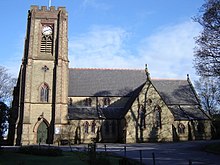St Paul's Church, Adlington
| St Paul's Church, Adlington | |
|---|---|

St Paul's Church, Adlington, from the south
|
|
| Coordinates: 53°37′00″N 2°36′04″W / 53.6166°N 2.6011°W | |
| OS grid reference | SD 603 135 |
| Location | Railway Road, Adlington, Lancashire |
| Country | England |
| Denomination | Anglican |
| Churchmanship | Catholic |
| Website | St Paul, Adlington |
| Architecture | |
| Status | Parish church |
| Functional status | Active |
| Heritage designation | Grade II |
| Designated | 13 July 1966 |
| Architect(s) | T. D. Barry and Sons |
| Architectural type | Church |
| Style | Gothic Revival |
| Groundbreaking | 1883 |
| Completed | 1884 |
| Construction cost | £8,000 |
| Specifications | |
| Capacity | 400 |
| Materials | Stone, slate roof |
| Administration | |
| Parish | Adlington |
| Deanery | Chorley |
| Archdeaconry | Blackburn |
| Diocese | Blackburn |
| Province | York |
| Clergy | |
| Vicar(s) | Fr David Arnold, SSC |
| Assistant priest(s) | Fr Eddie Carr |
| Laity | |
| Reader(s) | Barry Winstanley |
| Churchwarden(s) | Julia Henry, Christine Darbyshire |
| Parish administrator | Wendy Savage |
St Paul's Church is in Railway Road, Adlington, Lancashire, England. It is an active Anglican parish church in the deanery of Chorley, the archdeaconry of Blackburn, and the diocese of Blackburn. The church is recorded in the National Heritage List for England as a designated Grade II listed building. It is registered as a parish of the Society under the patronage of St Wilfrid and St Hilda.
St Paul's was built in 1883–84 and designed by T. D. Barry and Sons, at a cost of £8,000 (£750,000 in 2015). The tower was added following the First World War as a memorial to those who lost their lives.
The church is in Gothic Revival style, incorporating Early English and Decorated features. It is constructed in yellow stone with red stone dressings; the roof is of Welsh slate, with a crest of red tiles. The plan consists of a five-bay nave with a clerestory, north and south aisles, north and south transepts, and a chancel. At the southeast corner is a three-stage tower, containing an entrance porch in the bottom stage. The tower is supported by angle buttresses, it has paired bell openings and clock faces in the top stage, and a battlemented parapet. There were plans to have a tall spire, but this was never built. Along the sides of the aisles are single-light windows, with two-light windows in the clerestory. In the north and south walls of the transepts are two lancet windows with an oval window above.
...
Wikipedia

